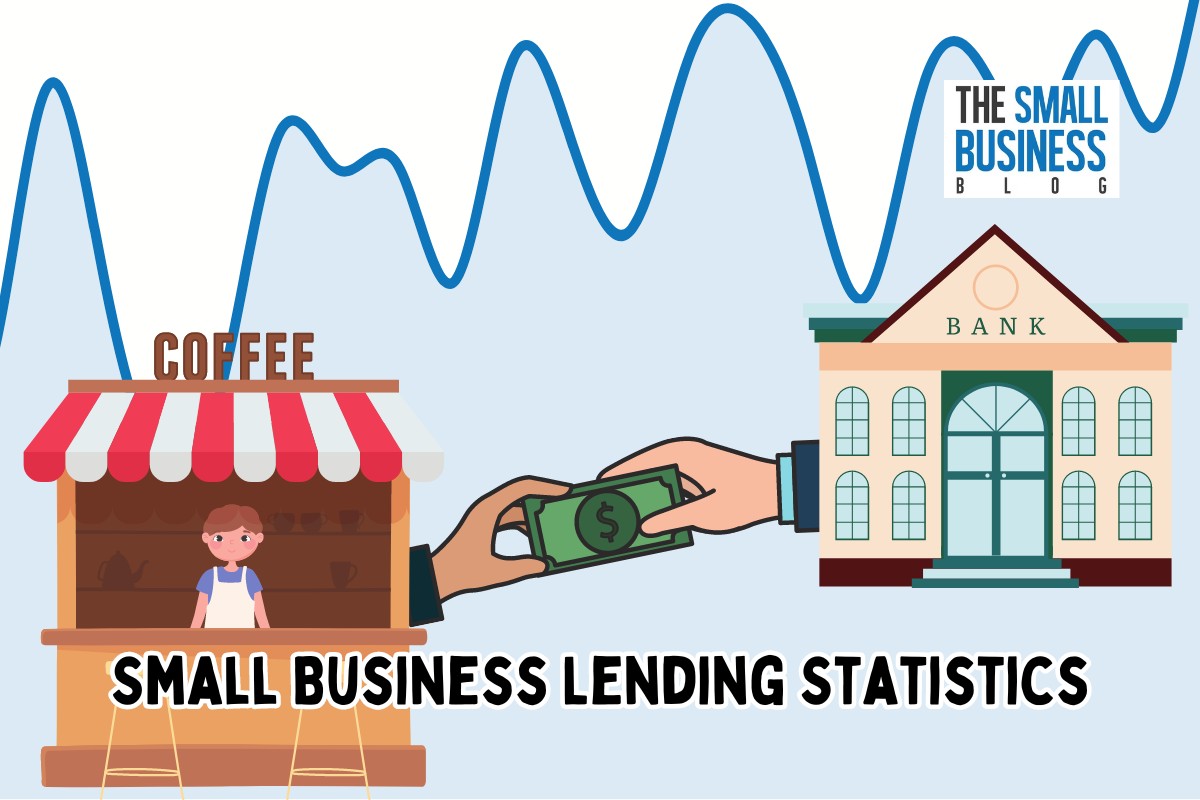Most people and businesses would prefer not to borrow money.
After all, borrowing money means you have to pay it back.
That can have a negative effect on cash flow in the future.
Of course, the reality is that most businesses need funds to get started.
Alongside this, small businesses often need finance to help them grow and expand.
As the following small business lending statistics show, if you’re looking for finance you’re not alone.
However, it can be more difficult than you might think to secure the funding you need.
Post Contents
- 1 Key Statistics
- 2 Top Small Business Lending Statistics in 2024
- 2.1 1. Less Than Half Of US Small Businesses Have Enough Finance
- 2.2 2. 70% Of Small Businesses Are In Debt
- 2.3 3. 38% Of Businesses Took Finance In 2020
- 2.4 4. Only A Third Of Businesses Survive Past 10 Years
- 2.5 5. The Average Small Business Loan Is $633,000
- 2.6 6. Only 13.8% Of Small Business Loans Are Approved By Large Banks
- 2.7 7. 32% Of Small Businesses Use Non-Bank Lenders For Finance
- 2.8 8. A Fifth Of Businesses Have Credit Issues Preventing Loans
- 2.9 9. Rural Small Businesses Are More Likely To Be Approved For Loans
- 2.10 10. Just 2% Of Loans Go To Black-Owned Small Businesses
- 2.11 11. 15% Of Loans Go To Construction & Renovation
- 2.12 12. Largest Percentage Of SBA Loans Go To Full-Service restaurants
- 2.13 13. 11 Industries Aren’t Eligible For Loans
- 2.14 14. 82% Of Small Businesses Fail Due To Insufficient Funds
- 2.15 15. 56% Of Businesses Request Funding To Meet Operating Expenses
- 2.16 16. SBA Interest Rates Average Between 10.5% And 16.25%
- 2.17 17. 85% Of Merchant Cash Advances Get Approved
- 3 Securing A Small Business Loan
- 4 Summing Up
- 5 Sources
Key Statistics
- Less than half of US small businesses have enough finance
- 70% of small businesses are in debt
- 38% of businesses took finance in 2020
- Only a third of businesses survive past 10 years
- The average small business loan is $633,000
- Only 13.8% of small business loans are approved by large banks
- 32% of small businesses use non-bank lenders for finance
- A fifth of businesses have credit issues preventing loans
- Rural small businesses are more likely to be approved for loans
- Just 2% of loans go to black-owned small businesses
- 15% of loans go to construction & renovation
- Largest percentage of SBA loans go to full-service restaurants
- 11 industries aren’t eligible for loans
- 82% of small businesses fail due to insufficient funds
- 56% of businesses request funding to meet operating expenses
- SBA interest rates average between 10.5% and 16.25%
- 85% of merchant cash advances get approved
Top Small Business Lending Statistics in 2024

1. Less Than Half Of US Small Businesses Have Enough Finance
Money makes the world go round.
Without it, no business or individual can survive.
Despite the importance of money, a recent survey by Zippia found that 52% of businesses didn’t receive the finance they needed.
In some cases, they received partial finance.
In others, for a variety of reasons, they didn’t secure any finance.
The survey found that just 20% of small businesses received the finance they applied for.
The remaining 28% of businesses had enough capital but this was only possible due to existing loans.
In short, the majority of US businesses are struggling daily without enough funds making it tough for them to survive.
(Zippia)
2. 70% Of Small Businesses Are In Debt
Although many businesses struggle to get the finance they need, that doesn’t mean they don’t already have finance.
In fact, in over a quarter of cases, the inability to get finance is directly tied to the level of existing debt.
According to the latest reports by Zippia, 70%, that’s nearly three-quarters, of all the small businesses in the US are in debt.
The report found that 38% of small businesses have debts under $100,000, meaning that 62% of small businesses have debts in excess of $100,000.
For some the debt figure is hundreds of thousands of dollars.
The smaller loan ratio can be divided further.
Statistics show 21% of small businesses have debts between $25,000 and $100,000.
Just 17% have debts below $25,000.
Impressively, 13% of small businesses owe between $100,000 and $250,000.
A further 13% owe between $250,000 and $1 million.
It’s potentially worse for the 6% that owe over $1 million.
Of course, the debt is relative to the turnover of each business.
(Zippia)
3. 38% Of Businesses Took Finance In 2020
There is little doubt that 2020 was a bad year for many small businesses across the globe.
A few businesses, such as Amazon, flourished during the pandemic.
However, for most, it was a challenge simply to stay afloat.
Interestingly, this led many businesses to take careful stock of their situation.
Statistics show that 38% of small businesses applied for a loan in 2020.
In a normal year the average number of businesses applying for loans is 58%
¨Part of this reduction is connected with a reluctance from businesses to expand.
After all, many small businesses struggled to make ends meet.
The other main reason for the reduction in loan applications was businesses pausing activities and deciding whether it was worth continuing ort not.
In many cases, this led to a loan application in 2021 as the small businesses saw a way forward.
(Zippia)
4. Only A Third Of Businesses Survive Past 10 Years
Starting a new business is challenging and you’ll probably be told most small businesses don’t make it.
However, this isn’t strictly true.
According to statistics, three-quarters of new businesses will survive the first year.
That’s understandable.
If you create a good business plan you’ll have the finances ready to handle the first couple of years of trading.
It’s after that finance runs out and you’re still struggling that businesses start to experience issues and are forced to close.
Reports show that only half of small businesses will make it to five years, and just 33% of them will survive longer than 10 years.
Of course, the statistics don’t show how many 10-year-old businesses have failed, how many have been sold, and how many have simply closed for other reasons.
(Zippia)
5. The Average Small Business Loan Is $633,000

Small business loan values vary greatly depending on the size of the small business and how long its been trading.
After all, a small business is generally classified as an y business with under 500 employees, that means they could have a significant turnover and still be a small business.
Businesses turning over millions don’t have an issue borrowing larger figures, especially if they feel they will get a good rate of return.
The result is a large discrepancy in loan amounts.
This pushes the average figure up and explains why, according to Zippia, the average small business loan is an impressive $633,000.
It’s worth noting that a small business can borrow funds from a regional or national bank and they’ll generally lend between $13,000 and $1.2 million.
In contrast, businesses tend to ask for less from non-bank lenders.
Statistics show that the average loan to small b businesses from this type of lender is between $50,000 and $80,000.
Some of the best-known non-bank lenders are Fundbox, Balboa Capital, and BlueVine.
(Zippia)
6. Only 13.8% Of Small Business Loans Are Approved By Large Banks
Small businesses traditionally approach banks to request finance.
However, in recent years there has been an increasing number of non-bank solutions, as well as businesses using smaller local banks.
This is driven by the low rate of approval by major banks.
Statistics show just 13.8% of small business loans are approved by large national banks.
In contrast, small local banks have seen an increase in approval ratings, they now approve 19% of loans.
The statistics also prove that non-bank loans are becoming the preferred choice for many businesses.
As many as 24.7% of applications are approved by non-bank lenders.
(Zippia)
7. 32% Of Small Businesses Use Non-Bank Lenders For Finance
The improving approval rates by non-bank lenders is encouraging more businesses to adopt this approach.
After all, there’s a better chance of success and that means you can keep your business afloat for longer.
Recent reports suggest that 32% of small businesses are now applying to non-bank lenders.
That percentage has grown significantly in recent years.
For example, in 2016, just 19% of small business loan applications were approved by non-bank organizations.
By 2017 this had risen to 24% and today it’s reached 32%.
It’s just a matter of time before non-bank lenders become the norm.
(Zippia)
8. A Fifth Of Businesses Have Credit Issues Preventing Loans
Applying for a loan as a small business isn’t much different to applying for a personal loan.
For an application to be successful the business, and its owners, need to have good credit.
This, combined with the age of the business, its cash flow, revenue, and marketing plan will make or break an application.
Unfortunately for 20% of small businesses, their credit rating isn’t good enough to secure the needed loan.
Interestingly, in many cases, this is a result of a lack of credit history or nearly no credit history.
Being turned down for a loan doesn’t mean the business is doing poorly.
Remember that personal credit and business credit can be different.
It’s a good idea to keep your eye on both credit ratings.
(Zippia)
9. Rural Small Businesses Are More Likely To Be Approved For Loans
Zippia recently surveyed businesses rurally and in urban areas to assess their loan success rate.
The survey found that small businesses in rural locations were more likely to get a loan than similar businesses in the city.
It was found that 51% of rural businesses received the full amount of the loan they requested.
In contrast, just 38% of city-based small businesses received the requested funds.
The survey doesn’t look at why this is the case.
However, it’s likely that rural businesses are better known by their banks and this could affect the finance decision.
Equally, a small percentage of businesses operate rurally.
This could mean finance companies are agreeing to loans to help ensure they show equality across applications.
It is worth noting that rural small businesses tend to rely on small banks.
62% of rural business loan applications go to small banks.
In contrast, just 53% of city applications do the same.
(Zippia)
10. Just 2% Of Loans Go To Black-Owned Small Businesses

There are approximately 330 million people; living in the US.
Roughly 13% of this population is made up of Black Americans.
However, the small business lending statistics don’t reflect this percentage.
According to recent reports just 2% of loans got to black-owned small businesses.
Studies also demonstrate the inequality afforded to black people as under 47% of black-owned small businesses have their loan approved.
It’s not just black Americans who struggle with finance.
According to the latest Zippia report, only 16% of small business loans go to women-owned businesses.
That’s despite the fact that 30% of small businesses are owned and run by women.
Studies show a woman business owner is more likely to have a loan application rejected than a male small business owner making the same application.
For those that are accepted, there are likely to be stricter terms than for a male!
(Zippia)
11. 15% Of Loans Go To Construction & Renovation
If you’re looking to start a business and want to in crease your chances of loan approval you could choose your industry accordingly.
According to the latest reports, an impressive 15% of loans are issued to businesses within the construction and renovation industry.
Of course, this industry does require a lot of dedicated tools and equipment.
That’s why most of these businesses apply for loans.
You may want to bear the startup costs in mind before committing.
The second most successful industry when it comes to loan approvals is the transport industry.
Purchasing one, or a fleet of trucks is not a cheap option!
(Zippia)
12. Largest Percentage Of SBA Loans Go To Full-Service restaurants
The Small Business Association (SBA), has its own loan scheme.
It’s one that many small businesses take advantage of.
The SBA helps with running your business or expanding it.
In fact, during 2020 over 90%of SBA loans were to help businesses survive the pandemic.
While any business can apply to the SBA for a loan, reports show that full-service restaurants make up the bulk of approvals.
The figures confirm that, in 2019, 28,680 full-service restaurants received an SBA loan.
The same year, 19,141 limited-service restaurants also received an SBA loan.
To illustrate just how big the gap is between restaurants and other industries, the third spot was taken by the dental industry.
However, they only enjoyed 10,699 loans in the same period.
(Zippia)
13. 11 Industries Aren’t Eligible For Loans
It may seem surprising in the modern age, but some businesses aren’t allowed to apply for loans.
It should be noted that illegal businesses will never apply for standard loans.
However, the following 11 industries are potentially legal yet still unable to get financial help if needed.
The industries include gambling, religious industries, real estate investment firms, speculation-based businesses, lending loan packaging firms, multi-sales distribution, MLM, non-profit, and government-owned businesses.
The law states that these firms can’t borrow money.
That means they have to find an alternate way to generate the finance they need.
(Zippia)
14. 82% Of Small Businesses Fail Due To Insufficient Funds
Nearly 80% of small businesses survive their first year.
However, just 33% are still grading after 10 years.
That means a lot of businesses fail along the way.
Unfortunately, the reason for business failure remains consistent across businesses and industries.
According to a recent survey, 82% of small business failures are a direct result of insufficient funding.
The same survey found that 42% of businesses felt a lack of potential customers contributed to their failure.
Twenty-nine percent of those asked simply ran out of cash, and 23% felt their chosen team didn’t work well together.
In just 19% of cases, small businesses failed because the competition did better than them.
The survey allowed for multiple responders, illustrating that while insufficient funds was a major contributory factor, it wasn’t the only thing causing small businesses to fail.
The truth is, that a lack of ability to access funds when needed is a major contributory factor to business failure.
Of course, better business planning and market analysis can help.
After all, a Goldman Sachs survey in 2021 found that 44% of small businesses had very small cash reserves to deal with emergencies.
Most of these businesses wouldn’t survive three months without financial help.
(Business Insider)
15. 56% Of Businesses Request Funding To Meet Operating Expenses
In a perfect world small businesses excel and the only time funds are needed is when you’re ready to expand.
Unfortunately, this isn’t always the case.
According to the Fed small business credit survey, over half of small businesses asked for loans simply to keep their company operational.
Thirty-one percent of businesses were preparing to grow and deal with a bright future.
These are the ones that asked for finance to expand or purchase new equipment and assets.
A further 13% of small businesses were looking to borrow to consolidate previous lending and potentially pay down some of the outstanding amount.
The rise in people needing funds for operational reasons can be linked to COVID-19.
The same survey conducted in 2019 shows that the majority of small business loans were for fixed asset and equipment purchases.
A marked difference from during the pandemic.
(Fed Small Business Credit Survey 2021)
16. SBA Interest Rates Average Between 10.5% And 16.25%
The exact fate of interest a business will be offered depends on a number of variables.
These include the size of the loan, the size of the business, credit rating, and what the funds are for.
In general, an SBA loan will have an interest rate between 10.5% and 16.25%.
In contrast, a commercial loan from a bank is likely to have an interest rate in the region of 30%.
In short, as the economy struggles and inflation rises, small business loans are becoming less affordable or desirable.
Of course, rising interest rates, coupled with long loan terms suit the lenders, they can theoretically collect a far greater sum than they lent you.
(SBA)
17. 85% Of Merchant Cash Advances Get Approved
Merchant cash advances have become a popular way to secure additional funding for small b businesses.
The merchant lends you funds based on your current level of electronic receipts.
They then deduct an amount from future receipts to cover the cost of the loan over an agreed period.
For the merchant, the process is comparatively safe, provided you keep making sales.
That makes it easier for them to approve requests.
It’s the main reason why 85% of merchant cash advances are approved; making it the highest type of funding for small businesses.
Of course, this type of funding is tied to your receipt level.
That means it’s generally a good approach to help with cash flow difficulties.
It’s less beneficial if you’re looking at expansion or asset purchase.
(Fundera)
Securing A Small Business Loan
The exact process of securing small business lending will depend on how well-established your business is, what the finance is for, and your credit rating.
However, you can increase your chances of a successful loan request, and become one of the favorable small business lending loan statistics by
Checking Your Credit Rating
You can check your credit rating with any of the major credit agencies.
You’ll need to check your personal rating and your business rating.
While you can’t quickly change your credit rating, you can take a moment to evaluate your debts.
If you’re able to eliminate any this will help your record and improve your chances of being approved for a small business loan.
Minimizing Debt
It may seem strange to use your capital to minimize existing debt simply to apply for more.
However, banks and other lenders like seeing debts paid off.
It makes you appear a safer risk.
Having A Good Marketing Plan
Perhaps the most important step is to make sure you have a good marketing plan and up-to-date accounts.
These show potential lenders that you’re organized, know where your money is going, and have a realistic plan for the future.
Anything that gives a lender confidence in your business will increase your chances of getting the funding you need.
Summing Up
As the small business lending statistics show, borrowing funds is essential for the majority of businesses.
Sadly, there are many challenges facing small businesses trying to secure lending.
Understanding the statistics will help you adopt the best approach and potentially increase your chances of securing finance.
Remember, sometimes it’s all about the lender you choose as opposed to your application.
Start by talking to the SBA and then carefully look at alternatives, there is likely to be an avenue which works for you.






























